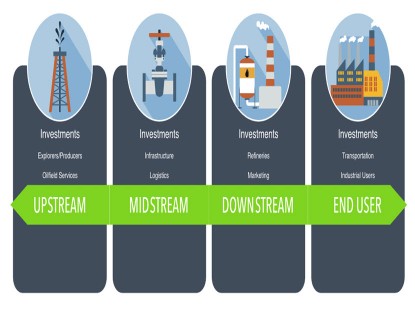What's Driving Midstream Company Performance?
The Portfolio Managers share their insights on midstream companies’ strong performance over the past year, companies’ capital allocation approach that is aligned with shareholders, and current valuations.
-
 Ben Cook, CFAPortfolio Manager
Ben Cook, CFAPortfolio Manager -
 L. Joshua Wein, CAIAPortfolio Manager
L. Joshua Wein, CAIAPortfolio Manager
Would you please discuss midstream companies’ performance compared to the overall market?
Over the past year through July 31, 2024, the Alerian US Midstream Energy Index rose nearly 33% while the S&P 500® Index climbed over 16%. We believe this fairly strong performance by the midstream sector relative to the overall market has been driven by improving fundamentals for crude oil and natural gas as well as continued midstream company emphasis on returning capital to investors. We believe these same drivers will continue to propel sector performance going forward.
How have midstream companies aligned interests with their shareholders?
Now more than at any time in the past, midstream companies are squarely focused on prioritizing cash use with investors in mind; paying down debt, repurchasing shares and hiking dividend payouts. This has been a fundamental shift in many companies’ management practice. Just a few years ago, capital allocation decisions were driven by a “growth for the sake of growth” mindset, influenced by incentives that benefited executive management and encouraged spending which often resulted in excessive leverage.
Dividend payouts continue to represent one of the more attractive components of the shareholder return feature benefiting investors. While recent equity performance has resulted in yields tightening relative to yield benchmarks, midstream sector payout rates remain attractive and well-funded by company level cash generation levels. As of 8/5/24, the average dividend yields of Midstream C-Corps and midstream master limited partnerships (MLPs) were 5.2% and 7.0%, respectively.1
In terms of dividend funding, company level cash coverage over dividend payout levels has improved materially. In 2019, the average distribution coverage in the midstream sector was 1.6x. In other words, every $1 in payout per share/unit was covered by $1.60 distributable cash per share/unit. In 2023, the coverage was 1.89x, generating $1.89 in distributable cash for every $1 paid to investors. Over the next 5 years, the average distribution coverage is expected to grow to 1.8 to 1.9x.1
We believe this shareholder friendly capital allocation process has been self-fulfilling in that it has and should continue to attract capital to midstream companies.
How could midstream companies play a role in providing back-up renewable power as the demand for artificial intelligence (AI) increases?
Natural gas is frequently referred to as a ‘companion fuel’ to renewables because, as a fuel source, it is typically called upon to satisfy electric power generation fueling needs in times of limited renewable power generation, typically after sunset or when wind power is at a minimum. AI computing needs will likely require around-the-clock power sources which will necessitate the availability of on-demand fuel sources including natural gas. Midstream companies that facilitate the transportation, storage, and distribution of natural gas to support these growing power generation needs will stand to benefit.
Would you please discuss valuations?
Recent midstream sector equity outperformance has resulted in compressed yield levels relative to historic norms, however, valuation remains attractive in our opinion, particularly given the additional cash return via debt reduction and share repurchases. Midstream MLP yield is approximately 7% versus the historical 10-year average of 8.5%. However, the valuation is 8.5x EV to estimated forward EBITDA relative to the 10-year average of 10.4x on that same basis.
What is your outlook for midstream companies for the remainder of 2024?
We see the current environment driving strong performance in midstream equities through the remainder of the year. Healthy global demand for U.S. hydrocarbons combined with commodity price stability afforded by OPEC+’s quota alliance should support continued strength in sector operating and financial results. Healthy sector cash generation will likely provide the flexibility for continued cash return as well as modest organic growth and merger and acquisition activity underpinning future operating cash flow growth. Additionally, a favorable election outcome could also unlock industry expansion optionality, which at the moment, garners little, if any, value in current equity pricing.
- In this article:
- Energy
- Midstream Fund
You might also like
-
 Investment Idea
Investment IdeaDefining the Energy "Value Chain"
 Ben Cook, CFAPortfolio ManagerRead the Investment Idea
Ben Cook, CFAPortfolio ManagerRead the Investment IdeaEnergy is a large and complex sector. The sector’s broad sub-industries can be divided into a “value chain,” each segment of which has different characteristics and offers different investment opportunities.
-
 Portfolio Perspective
Portfolio Perspective
Energy Transition FundEnergy - Attractively Valued Sector with Higher Free Cash Flow Yields
 L. Joshua Wein, CAIAPortfolio Manager
L. Joshua Wein, CAIAPortfolio Manager Ben Cook, CFAPortfolio ManagerRead the Commentary
Ben Cook, CFAPortfolio ManagerRead the CommentaryIn the following commentary, Portfolio Manager Ben Cook and Josh Wein discuss the Fund’s disciplined process throughout the volatility driven by tariff uncertainty and geopolitical developments.
-
 Portfolio Perspective
Portfolio Perspective
Gas Utility FundNatural Gas: Essential to Reliable Power
 Ryan C. Kelley, CFAChief Investment Officer and Portfolio Manager
Ryan C. Kelley, CFAChief Investment Officer and Portfolio Manager L. Joshua Wein, CAIAPortfolio ManagerRead the Commentary
L. Joshua Wein, CAIAPortfolio ManagerRead the CommentaryUtilities have delivered strong returns in 2025, fueled by demand trends, earnings growth and their defensive nature, positioning natural gas utilities as a compelling opportunity amid market uncertainty.
